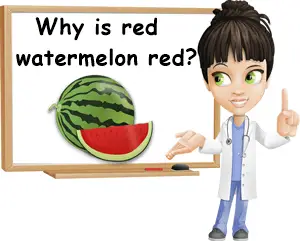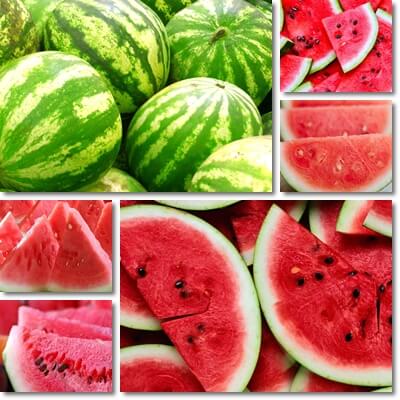Of all the different types of watermelon, red watermelon is by far the most common variety. Sweet, juicy and crisp, it’s a favorite summer fruit as well as healthy and good for a number of things, including high blood pressure, skin and vision. But why is watermelon red inside? What makes red watermelon red inside is its high content of red pigmented components such as the carotenoid lycopene.
Other orange and red pigments such as beta-carotene and alpha-carotene also contribute to the red color of watermelon flesh, but to a lesser extent compared to lycopene.
What makes watermelon red inside?
What makes watermelon red inside is also what makes tomatoes, tomato juice and sauce, ketchup, guava, papaya, Cara Cara oranges and gac fruit red: lycopene. Lycopene is a pigment and carotenoid antioxidant that gives some foods a pink or red color. In red watermelon, lycopene is the primary pigment and the biggest contributor to flesh color. But there are other pigments aside from lycopene that also make red watermelons red inside, notably beta-carotene, alpha-carotene and gamma-carotene.

Depending on the exact ratio of each pigment, various shades of pink and red are possible. Lastly, the low content of yellow pigments, lower than red ones at least, further contributes to the striking red color of watermelon, despite not actually being what makes watermelon red inside.
Why is watermelon pink instead of red?
Sometimes watermelon is pink inside instead of red. But why? Pink and red are essentially variations of the same color and what makes watermelon red inside is also what makes it pink. Both pink and red watermelons owe their flesh colour primarily to lycopene, a bright red pigment and antioxidant carotenoid, and, to a lesser extent, to other pigmented components such as beta-carotene, alpha-carotene, gamma-carotene etc.
But pigments vary in content between cultivated varieties of the fruit, hence the variations in watermelon flesh color. So if your watermelon is not quite red inside, it’s likely because it has a lower content of certain pigments compared to watermelon that is bright red inside (for example, lycopene content may vary, and so can beta-carotene and other pigments).
Why is watermelon dark red?
There’s pink watermelon and there’s red watermelon and then there’s dark red watermelon. But what makes watermelon dark red inside? Simple: a higher concentration of red pigments, higher than orange and yellow ones. Watermelon with a dark red flesh color is high in lycopene, a bright red pigment and carotenoid antioxidant also responsible for the color of red carrots, tomatoes and gac fruit, among other foods.
Other pigments, notably beta-carotene and other carotenes, also contribute to the dark red color of some watermelon varieties, but to a lesser extent. So what makes watermelon dark red inside is what makes it pink and regular red – high concentrations of carotene antioxidants such as lycopene, but also beta-carotene, and a lower content of yellow pigments such as xanthophylls.

Which color is watermelon normally?
Have you ever wondered why are watermelons commonly red inside instead of other colors? There’s actually no normal watermelon color. Watermelons naturally come in a variety of colors, including pink, red, red-orange, dark red, salmon, greenish-white, orange and yellow. Sometimes your watermelon can be both red and yellow inside, or yellow and orange. Red (and its variations: pink, salmon, red-orange, dark-red) just happen to be more common at the moment.
A long time ago, watermelons were actually a greenish color inside, until they were brought into cultivation and bred to obtain the beautiful bright colors we enjoy today, and the taste.
Nowadays we have yellow watermelon, pink and red watermelon, orange watermelon and also white watermelon.
Which color watermelon is best?
Are darker or lighter red watermelons better? Or is yellow watermelon the best color? Or orange maybe? There really isn’t such a thing as the best or healthiest watermelon color – while each watermelon color provides a specific ratio of pigments and nutritional components, all contribute to our daily nutritional status and good health.
Overall, watermelon is good for the heart and cardiovascular system, eyesight and skin, and boosts energy levels and the immune function. Eating watermelon helps lower blood pressure numbers, cholesterol levels and combats tiredness and fatigue and low blood sugar. Watermelon is good to eat with diabetes, in limited amounts of course, and is a great anti-inflammatory food.
Also see the benefits of yellow watermelon.
What color watermelon is the sweetest?
If you had to choose between pink, regular red and dark red watermelon, which color do you think is the sweetest? There are well over 1000 different watermelon varieties, one sweeter than the other. But you can get both good-tasting and bad-tasting watermelons irrespective of flesh color. One day you can have a dark red watermelon that is sweet like honey and fresh and flavorful, and then get one with not that much of a taste.
Similarly, you can have excellent tasting pink watermelons for years on end, then come across bad or bland ones. Growing conditions, ripeness and many other factors aside from variety go into producing sweet and flavorful watermelons.
